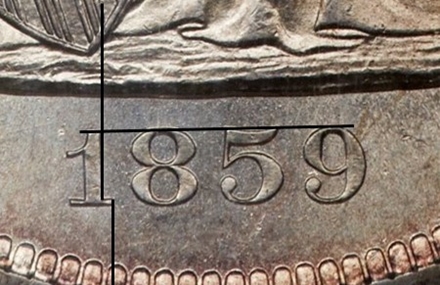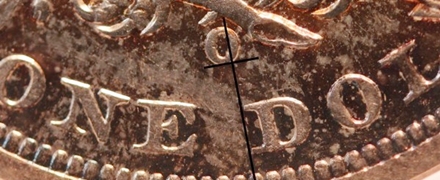|
|
Comments: This is the second of three uses of Obverse 1 and the only use of Reverse A. |
Obverse 1 The photo below shows the Obverse 1 attribution grid. Obverse 1 exhibits no notable markers, but with only two obverse dies known the date position is sufficient for attribution.  1859-O Obverse 1 attribution grid
 1859-O Obverse 1 die state b clash marks  1859-O Obverse 1 die state d clash marks No later states have been observed. I've seen only a single photo of obverse die state c. Unfortunately the resolution wasn't good enough to use it for this book. I believe that the die clashed a second time and was quickly removed from service and polished. An example with this die state would be extremely rare. |
The photo below shows the mintmark position for Reverse A.  1859-O Reverse A mintmark Reverse A exhibits no notable markers. The mintmark position is similar to Reverse D. The mintmark has a slight clockwise rotation, different from Reverse D, which exhibits almost no mintmark rotation. The reverse die cracks are unique. Since most coins exhibit at least a few of them they can be used to confirm the attribution.
 1859-O Reverse A Die Cracks No later die states have been observed, although a later state probably exists based on the heavy deterioration of this die during its lifetime. |
| Photo credits:
Obverse 1 and Reverse A die cracks: 1859-O NGC MS65, tied for finest known, ex. Gene Gardner, from the Heritage archives. Obverse 1 die state b: 1859-O PCGS AU53, from the Stacks-Bowers archives. Obverse 1 die state d: 1859-O ICG MS63, from the Stacks-Bowers archives. Reverse A: 1859-O ANACS MS60 cleaned, from the Osburn-Cushing reference collection. |
